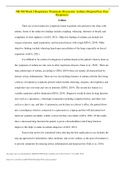Other
NR 566 Week 2 Respiratory Treatments Discussion: Asthma (Original Post, Peer Responses)
NR 566 Week 2 Respiratory Treatments Discussion: Asthma (Original Post, Peer Responses) Asthma There are several subjective symptoms found in patients who present to the clinic with asthma. Some o f the subjective findings include coughing, wheezing, shortness of breath, and complaints of chest tig...
[Show more]
Uploaded on
June 7, 2022
Number of pages
5
Written in
2021/2022
Type
Other
Person
Unknown
Institution
Chamberlain College Of Nursing
Course
NR 566
All documents for this subject (416)
$10.99
Also available in package deal from $20.49
100% satisfaction guarantee
Immediately available after payment
Both online and in PDF
No strings attached
Also available in package deal (1)
NR 566 Entire Course Week 1 – 8 BUNDLE (100% CORRECT SOLUTION) | LATEST UPDATES | Guaranteed Pass
$ 318.71
$ 20.49
29 items
1. Other - Nr 566 week 1 clinical case study graded discussion (original post, responses) 118 pa...
2. Exam (elaborations) - Nr 566 week 1 quiz (100% correct collection) | latest update
3. Other - Nr 566 week 2 respiratory treatments discussion: asthma (original post, peer response...
4. Other - (part 2) nr-566 week 2 respiratory treatments discussion: copd management (original p...
5. Exam (elaborations) - Nr 566 test bank questions and answers for weeks 5 | 100% guaranteed pass | top score
6. Other - Nr 566 week 3 hypertension guidelines discussion (graded a)
7. Other - Nr 566 week 3 rx writing assignment: carvedilol 25 mg tablets (top score)
8. Exam (elaborations) - Nr 566 week 3 quiz (100% correct solutions) | chamberlain college of nursing
9. Exam (elaborations) - Nr 566 week 4 midterm review (questions and answers) | 100% correct solutions
10. Other - Nr 566 week 5 assignment: immunization – hepatitis b (graded a+)
11. Case - Nr-566 week 5 assignment: immunization – hpv and rotavirus (top score)
12. Case - Nr 566 week 5 assignment: immunization – pneumococcal 13-valent conjugate (pcv13)
13. Case - Nr 566 week 5 assignment: immunization – pneumococcal 23-valent polysaccharide (pps...
14. Case - Nr-566 week 5 assignment: immunization – varicella (var)/ (graded a+)
15. Case - Nr 566 week 6 grand rounds presentation part 1 – heart failure due to reduced eject...
16. Case - Nr-566 week 6 grand rounds presentation part 1 – vaginitis | top rated paper
17. Case - Nr 566 week 6 grand rounds presentation part 1 – menopause | already graded a
18. Exam (elaborations) - Nr 566 week 6 quiz (100% correct solutions) | download to score an a
19. Other - Nr 566 week 7 rx writing assignment/ prescription week 7 (already graded a)
20. Other - Nr 566 week 8 reflection assignment.
21. Exam (elaborations) - Nr 566 exam preparation :week 5 chapter 19: drugs affecting the immune system (test b...
22. Exam (elaborations) - Nr 566 exam preparation: week 5 chapter 27 anemia (graded a) questions and answer sol...
23. Exam (elaborations) - Nr 566 exam preparation: week 5 chapter 37: hiv | top score | already graded a
24. Exam (elaborations) - Nr 566 exam preparation: week 6 chapter 22 drugs affecting the reproductive system (t...
25. Exam (elaborations) - Nr 566 exam preparation: week 6 chapter 31 contraception (top grade) | latest update
26. Exam (elaborations) - Nr 566 exam preparation: week 6 chapter 38: hormone replacement therapy and osteoporo...
27. Exam (elaborations) - Nr 566 exam preparation: week7 ch. 48 women as patients (graded a) questions and answ...
28. Exam (elaborations) - Nr 566 exam preparation: week 7 chapter 49 men as patients | download to score an a
29. Other - Nr 566 week 8 final review-study guide (final pointers) | download to score an a
Show more
1




